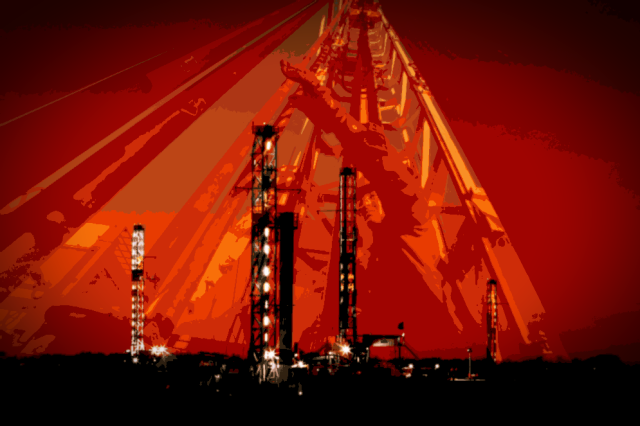
(Source: Hart Energy)
While downturns always sow the seeds for upturns, the current oil market collapse may have a more dramatic impact on the U.S. land market than previous downturns, Evercore ISI analysts said in a recent webinar.
Expectations for a third consecutive year of positive E&P spending growth shifted to double-digit declines across all the geographic regions, said James West, senior managing director of oil services, equipment and drilling research with Evercore.
“U.S. shale has been impaired, the market has been reset and we think that we have a new normal for the U.S. oil market with only about 400 to 450 rigs and about 150 to 200 frac spreads to support the lower supply levels,” he said.
After the U.S. land rig count declined by 51% in the second quarter, the average dropped another 36% in the third quarter. However, the latest weekly U.S. land active rig count is at 252, the same as mid-June levels, which shows that the rig count has stabilized.

“Even though declining well productivity and increasingly challenging geological conditions could create temporary spikes in demand, but we certainly don’t need 800 to 1,000 rigs and 300 frac spreads,” West said
Evercore expects rigs will be added to the field early next year as budgets will reset after DUCs get worked down. However, Stephen Richardson, senior managing director and head of oil and gas, E&P research at the firm, anticipates a slower demand recovery for E&Ps, citing OPEC+, the upcoming elections and progress on ESG initiatives, particularly on the governance side, as the main reasons.
According to Richardson, the energy industry has been underperforming compared to other industries through September due to investor apathy and regulatory uncertainty alongside rising COVID-19 concerns. Though with a resumption of activity in the second half of the year as producers returned from mid-year shut-ins, there has been a marked increase in the pace of well completions.
“We want to be very clear that the uptick in activity witnessed in 3Q is really very transitory in nature,” he said.
RELATED:
Patterson-UTI Sees Shale Activity Picking Up through Early 2021
Even though increasing completions across shale basins will contribute toward stabilizing the U.S. supply, he noted the uptick in activity should not be confused with “growth aspirations.”
“The industry is not positioned to return to growth,” he said. “Capital remains scarce for all except the highest quality producers and credit markets remain in the driver’s seat. The market continues to reject growth plans from poorly capitalized or smaller producers who do not generate material free cash flow.”
The driver of slower growth has been consolidation. M&A activity picked up during the last few months as consolidation accelerated with seven deals valued over $100 million driving nearly $21 billion in aggregate deal value—a level not seen since the second half of 2018.
“We have had a busy third quarter for consolidation,” he said.
Richardson said transactions like Chevron Corp.’s acquisition of Noble Energy and the Devon/WPX Energy merger headlined the deal flow and were large contributors to more than 300 MMbbl/d of daily oil production. He also pointed out that bankruptcies and restructurings have not declined despite the summer rebound in oil prices.
So, how does the path back to prosperity look for the oil and gas industry as a whole?
“A couple of things need to happen,” West said. “First, we are going to see a course of major restructurings, which is unfolding. Step two is the onset of three events—widespread bankruptcies, massive asset retirements and a major M&A cycle—all of which are critical to address the oversupply of commodity equipment plaguing the market. And lastly, we need rapid, widespread and accelerated digitalization of the industry.”
A proprietary survey of energy leaders conducted by Evercore showed that majority of oil and gas executives recognize the importance of digitalization despite not having advanced capabilities at this stage. While 38% respondents said new technologies and digital solutions like artificial intelligence and machine learning will be critical for the oil patch, almost half of them believe new technologies will play an important role, moving forward.

In addition to digitalization, Evercore analysts see a momentum building for the oilfield services sector to play a key role in the energy transition.
“We expect LNG and hydrogen to be mega-themes to drive the next upturn with oilfield service companies playing a key role in the infrastructure buildout of the energy transition,” West said adding, “The hydrogen narrative took top billing during second-quarter earnings and should be a key theme for the next few quarters.”
Companies like Baker Hughes and FTI are furthest along in their involvement with this “new fuel source,” but West expects additional companies to tout offerings in what he called the “multi-decade growth theme.”
Additionally, he said key LNG companies are in significantly better financial position than E&Ps. Despite about $100 billion of LNG-related project spend has been deferred this year, he expects these projects to advance in the coming years. Meanwhile, the U.S. gas basins should continue to see a relative uptick in demand for drilling and stronger LNG exports, which he added will support the longer-term supply/demand narrative.
Recommended Reading
BP Restructures, Reduces Executive Team to 10
2024-04-18 - BP said the organizational changes will reduce duplication and reporting line complexity.
Matador Resources Announces Quarterly Cash Dividend
2024-04-18 - Matador Resources’ dividend is payable on June 7 to shareholders of record by May 17.
EQT Declares Quarterly Dividend
2024-04-18 - EQT Corp.’s dividend is payable June 1 to shareholders of record by May 8.
Daniel Berenbaum Joins Bloom Energy as CFO
2024-04-17 - Berenbaum succeeds CFO Greg Cameron, who is staying with Bloom until mid-May to facilitate the transition.
Equinor Releases Overview of Share Buyback Program
2024-04-17 - Equinor said the maximum shares to be repurchased is 16.8 million, of which up to 7.4 million shares can be acquired until May 15 and up to 9.4 million shares until Jan. 15, 2025 — the program’s end date.





